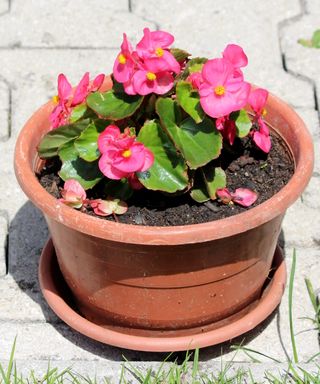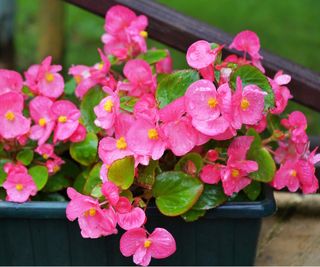Container gardening is a great way for plant lovers to create a jungle of lush foliage and flowers in very little space, and it also helps promote healthier growth for some plants. Begonias are one of those plants that love to grow in pots, look beautiful in them, and brighten up any container arrangement.
If you've been scouring the web for the perfect container garden ideas for your space or looking for ways to jazz up your spring containers for summer, you should definitely consider growing begonias. These vibrant flowering plants are native to subtropical regions of South America, Africa, and Asia and produce blooms in a variety of colors, from yellow to pink and even white.
These plants are easy to care for indoors or outdoors in U.S. hardiness zones 9 and 10, and their optimal growing conditions make pots a better environment for begonias. There are a few things to keep in mind when growing begonias in pots, and the experts are here to tell you all about them.
(Image credit: Jacky Parker Photography via Getty Images)
5 Expert Tips for Growing Begonias in Pots
Begonias are some of the most attractive flowers in late summer. Their lush foliage and large flowers make them perfect for outdoor table decorations and keep your garden bright throughout the warmer months. Here's what the experts have to say about how to successfully grow begonias in pots.
1. Choose a pot with drainage holes

(Image by hecos255 via Getty Images)
As with growing anything in a pot, you first need to make sure you have a suitable container to grow the plant in. When it comes to begonias, experts say drainage holes are essential.
“Choose a pot that has drainage holes and is slightly larger than your begonia's root ball,” says plant expert Autumn Janus of Perfect Plants.
Avoid choosing a container that is too large, as this will cause the soil to retain excess moisture and can quickly cause root rot.
“Choose a container that's wider than it is tall, often called an azalea pot or bulb pot. Most begonias have shallow roots, so this type of pot is perfect for them,” says Lisa Eldred Steinkopf, houseplant expert at The Houseplant Guru. “Because begonias are more of a succulent, they don't like their roots to be wet, so use a clay pot,” she adds.
Clay pots are more porous than other materials and have excellent drainage, which is why terracotta indoor planters are perfect for both indoor and outdoor potted plants.
There are plenty of suitable pots available online, so you can find one that suits your aesthetic, like this terracotta planter from Amazon.

Social Links Navigation
Plant Expert
Autumn is a Horticulture Specialist and Marketing Professional at Perfect Plants Nursery. With four years of experience in the horticulture industry, Autumn is passionate about helping people create beautiful indoor and outdoor spaces for them to enjoy. Autumn's horticultural expertise spans a wide range of activities including plant care and selection, landscape design and maintenance.

Social Links Navigation
Plant Expert
Lisa is a houseplant expert with over 10 years of experience at Steinkopf Nursery and Garden Center in Michigan and the blog, The Houseplant Guru. As a child, Lisa helped her grandmother care for African violets and other houseplants. Since then, Lisa has made a career offering houseplant advice, speaking, and writing for publications across the US.
2. Use well-drained potting soil

(Image credit: Tom Meaker via Getty Images)
No matter where you grow your begonias, whether you're looking for potting soil for indoor plants or the best soil for container gardening, well-draining potting soil is essential.
“Begonias need rich, well-drained soil,” says Julie Borden Davis, indoor plant expert at Healthy Houseplants. “You'll want a soil that contains peat moss or coco coir to retain moisture, and pumice or perlite for drainage,” she adds.
Begonias aren't the most water-hungry houseplants, but they do not like to dry out. Using a potting soil that provides adequate moisture while removing excess water will help your begonias thrive and prevent problems.
Find the right potting soil for begonias online, like this moisture control potting soil from Amazon.

Social Links Navigation
Plant Expert
Julie Borden Davis is a horticultural author, a University of California Certified Master Gardener, and the author of several gardening books, including “Indoor Gardening The Organic Way.” She runs HealthyHouseplants.com and shares indoor gardening advice on her YouTube channel, @HealthyHouseplants.
3. Water your potted begonia thoroughly.

(Image credit: YONCA60 via Getty Images)
When you first pot your begonia, water it thoroughly to help it become accustomed to its new environment, but be careful to reduce watering thereafter so the soil doesn't become soggy.
“Keep your watering habits consistent; begonias need even moisture, so you should water when the top 1.5 cm of soil feels dry to the touch,” says Autumn Janus.
“It depends on the season. When it's hot, they need to be watered more frequently. Generally, begonias should be watered every two to four days,” she added.
There are tools out there to help you water your plants properly, like this moisture meter from Amazon.
4. Place your potted begonia in a bright location

(Image credit: Botany vision via Getty Images)
Like other flowering plants or indoor flowering plants, begonias need plenty of natural light to keep blooming.
“Begonias should be placed in a spot with shade or bright indirect light, not in direct sunlight,” says Julie. Direct sunlight can burn your begonia's leaves and flowers, while too little light can make your begonia droopy and stop it from blooming.
If you’re growing potted begonias indoors and have trouble getting enough natural light, try using a grow light for houseplants, like this grow light from Amazon, to help them grow even better.
5. Fertilize your begonias while they are blooming

(Image by Rizky Panuntun via Getty Images)
Experts also recommend fertilizing begonias during their active summer growth period, which will help them bloom more abundantly and produce more vibrant flowers.
A balanced fertilizer works well for begonias, like this all-purpose fertilizer from Amazon, or you can choose a fertilizer high in phosphorus (NPK Plant Fertilizer No. 2), a nutrient that promotes flowering.
Alternatively, you can make your own plant fertilizer to feed your begonias using organic materials from your kitchen cupboard.
FAQ
How do I protect my potted begonias in winter?
Begonias prefer warm climates and cannot tolerate freezing temperatures in winter. Therefore, it is best to overwinter your begonias and let them bloom again next summer. The best solution is to bring your potted begonias indoors during the winter and keep them warm. Also, reduce watering and stop fertilizing your begonias so they don't get saturated while they are not actively growing. Make sure they get plenty of natural light during this time too.
Growing potted begonias requires some basic care to keep them blooming and healthy, plus, growing these beautiful flowers in containers makes them easy to move around.
If you're thinking about expanding your potted plant collection this summer, make sure you understand the container gardening mistakes to avoid.


